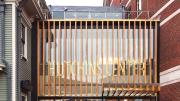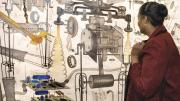As the Harvard Art Museums announced their long awaited re-opening with a series of community celebrations—catered events, held beneath the cathedral heights of the glass ceiling designed by Renzo Piano—another Harvard art gallery, tucked next to Peet’s Coffee & Tea in the Square, also opened its doors: the Ethelbert Cooper Gallery of African & African American Art.
Piano has called the roof of his building a “lantern” (see “Unleashing Harvard’s Art Museums,” November-December 2014). By coincidence, architect and W.E.B. Du Bois medalist David Adjaye used the same term to describe his vision of the new addition to Harvard’s Hutchins Center for African and African American Research. But the Cooper Gallery shines very differently. Amid the dense red brick of its neighbors on Mount Auburn Street, its wood paneling seems to glow at night. Visitors get their first look into the building through slices of glass, between tall cedar slats. Adjaye built the gallery’s façade to resemble a forest; its doors, also glass, form a clearing that welcomes people in.
“Wood and water are the critical materials of the Middle Passage story,” the architect said at a panel discussion in late October. They are, he added, “totemic” of the history between Africa and America. When considering how best to add to what he called the “perfect urban set piece” of Harvard, Adjaye resolved to build a façade that expressed a civic spirit. He wanted something visibly distinct and slightly removed from its neighbors’ commercial traffic—nothing that resembled a “lobby for an office building.”
Hutchins Center founding director and Fletcher University Professor Henry Louis Gates Jr. told the audience the gallery’s creation story, one that harkened back to the night he first showed donor Ethelbert Cooper the place that could bear his name, when they peered through the darkened windows in an icy December rain. Less than five years later, with the Cooper Gallery debuting with its first exhibit, Luminós/C/ity.Ordinary Joy, Gates asked, “I mean, who says that there aren’t miracles, right?”
For gallery director Vera Ingrid Grant and her staff, the story has just begun: “We are still grappling with how the space can receive art,” she says. “This will be a test year for us.”
For Luminós/C/ity.Ordinary Joy, co-curators Adjaye, Grant, and Mariane Ibrahim-Lenhardt chose 98 works by 21 artists to explore life in urban Africa. Few of the works were put under glass, and the labeling was kept minimal, to foster freer encounters with the art. “People bring their own intelligence to visual culture,” explains Grant. “Having screens and veils and filters on the art is something we wanted to dispense with. We have no acrylic barriers, so why have textual ones?”
The exhibit, which includes sculpture, video performance, painting, and paper architectural models, is designed to be experienced twice. After reaching the last work—an eight-foot wood-and-rope bicycle—visitors must double back on their initial path to exit, and encounter the pieces from new angles. As the curators arranged groups of artworks in each of the gallery’s eight spaces, which they nicknamed “neighborhoods,” they imagined the pieces speaking to each other; this floor plan ensures that no one artist gets the last word. A linear experience would seem like a lecture. This circular path creates an ongoing conversation, alive with echoes and unexpected contradictions—a playful cacophony.
Luminós/C/ity.Ordinary Joy will be on view until January 8. (A full exhibition catalog is available either at the gallery or online, as of January, from Harvard University Press.) In the spring, the Cooper Gallery will feature a traveling exhibit, Drapetomanía. Curated by Bliss professor of Latin American history and economics Alejandro de la Fuente, it pays tribute to the artists of a little-known movement in 1980s Cuba, whose work championed the centrality of Africa in Cuban culture.











